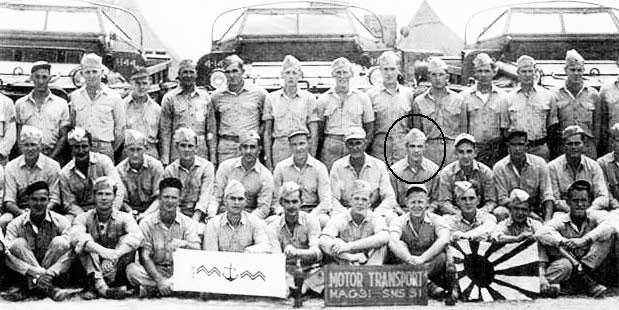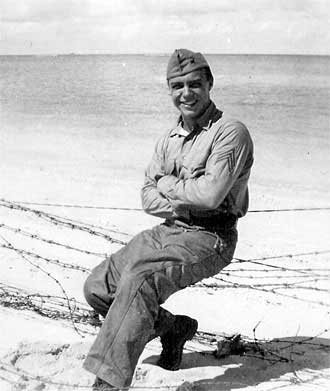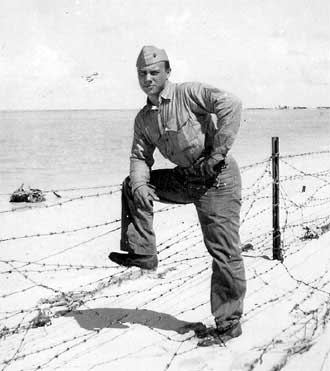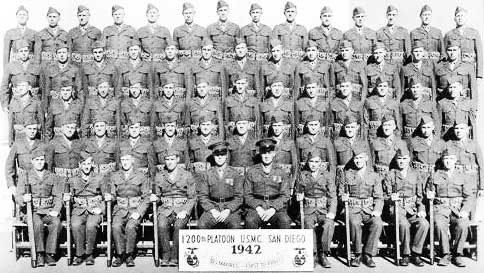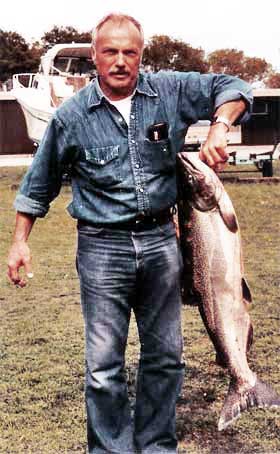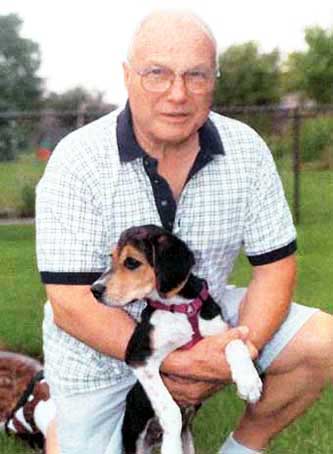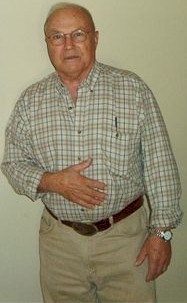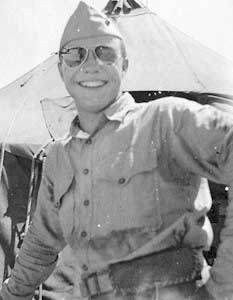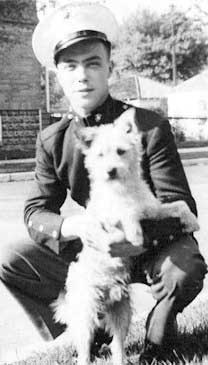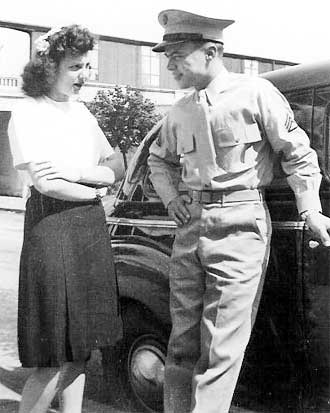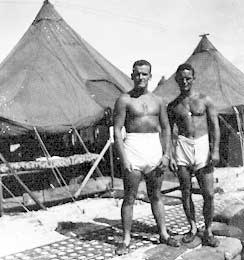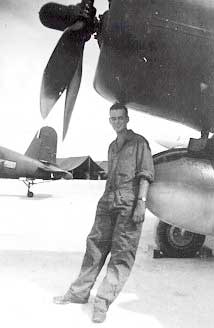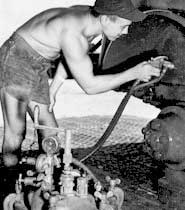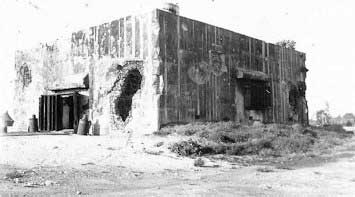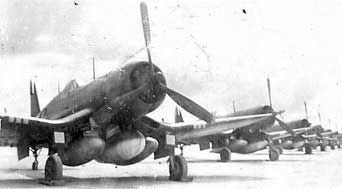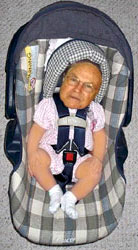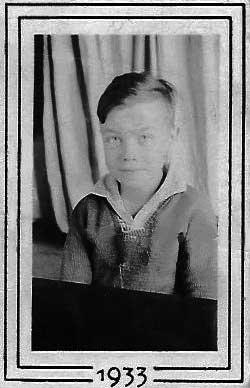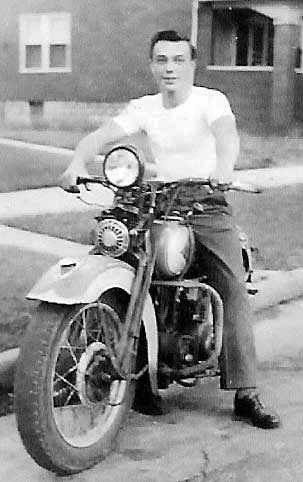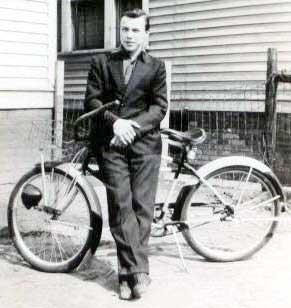|
||||||||
I was on Roi-Namur for a short time, from Feb. 5 until the later part of Dec 1944. All I can add to this is that the war in the Pacific was going on hot and heavy and the islands were in a mess. The air strip occupied most of Roi and we Marines and Seabees lived on Namur. The Marines and Seabees killed in action and were buried beside the causeway were later dug up and re-buried on another part of the island so they could widen the causeway from Roi to Namur. Traffic was getting heavier between the two islands. Some B-29s and other aircraft that were too shot up from bombing runs on Japan and other Japanese held islands to fly any further, landed on Roi, some crash landed. In spite of all the military action going on around, I found time to do a little fishing. They tied up a landing craft in the lagoon close to the mess hall, and they would dump all the garbage from the mess hall into the landing craft and dump it out into the ocean about once a week. The fish would hang out around the leaking landing craft and I invented a snag hook to catch them. I lowered the snag hook into the water and sprinkled some "C" rations (corned beef hash) around the hook, and when the fish went crazy eating the hash, I lifted the hook real fast and snagged them. They fried up delicious. When I caught too many, I would take a bagful of fish over to the mess hall and they were happy to get fresh fish. Semper Fi Herb |
||||||||
|
||||||||
| Story by Herbert H. Hice | ||||||||
|
We were on Wallis Island for
about 4 months. Then we boarded the USAT Jane Adams heading north for the invasion
of the Marshall Islands, Kwajalein atoll. MAG-31 needed the air strip on Roi-Namur. I went ashore on 5 Feb 1944. The islands were secured and the
bodies of the Jap soldiers were being buried in bomb craters with bull dozers from the Sea
Bees. The American Marines killed in action were buried in single graves along side
the causeway connecting Roi to Namur. The Sea Bees were working around the clock
rebuilding the airstrip on Roi. They needed more 6x6 dump truck drivers, so I became
a 6x6 dump truck driver. The airstrip repair was moving along very well until the
nigh of Feb 12 when the Japs launched a massive air raid on Roi. They dropped a lot
of incendiary bombs and most of the island and all our supplies were set on fire. One of the bombs exploded close to me and I was knocked unconscious and burned over a
large port of my head and body by the flaming jelly that makes up an incendiary bomb.
I was helped up by two buddies and bandaged up by the medics. I was put on a
landing craft with many other wounded Marines and Sea Bees. We were taken back to
the Jan Adams, which were turned into a hospital ship because there were so many wounded
Marines and Sea Bees. After a few days, the hospital ship headed back to Hawaii.
It took us about 3 weeks to get to Hawaii because the ship zig-zaged all the way
back. The ship traveled down below the equator and then back up to Pearl Harbor.
I and other wounded Marines and Sea Bees were taken to Aiea Heights Naval Hospital.
I was in the hospital for about 2 weeks and then moved to a staging camp for about
another 2 weeks. Other Marines and myself from MAG-31 were taken aboard another ship
that already had MAG-32 Marines from Cherry Point, heading to other islands in the Marshall
group. We, MAG-31 Marines, were put ashore on one of the outer islands with an
airstrip. We were then air transported to Dyess airfield on Roi-Namur where we
rejoined MAG-31. I did not have any particular job when I returned. i was
assigned the job of painting our trucks, jeeps and other equipment as the salt air was
very corrosive. They set me up in a large ten next to the portable machine shop
trailer. I think the machinists name was Hilla. I had one Marine helper.
We would scrape the rust off the vehicle and spray Zinc Chromate Primer on them and
then spray over the Marine dark green finish coat. My helper and I got to be pretty
good spray painters. I worked on that job until Dec 1944 when I was sent back to
Pearl Harbor and from there on to San Diego, CA with a 30 day furlough. After the
furlough, I reported to the air base at Quantico, VA. On Feb 16, 1945, I was stationed at
Quantico until Oct 1945. Where I received my Honorable Discharge. MAG-31 Comm 1, Feb43 at Cherry Point. Trasf to Miramar for embarkation and in late Sep 43 sailed for Samoa. By 6 Oct 43 units had been disembarked and station at various Samoan bases. In Jan a fighter squadron went to Funafuti, and a night-fighter Squadron left for Tarawa, deploying MAG-31 units from American Samoa to the Gilbert Islands. By 7 Feb 1944 forward etch had moved into Marshalls to base at Roi. By middle of March 1944 neutralization of by-passed Marshall Islands' bases had begun. On 7 Apr 45 arrived Yontan for Okinawa campaign. MAG-31 operated from 7 Apr to 15 Aug 45 over Kyushu, the China coast, East China Sea area, and over more than a dozen enemy-held islands between Formosa and Kyushu, in addition to furnishing close support on Okinawa. About Wallis Island: The movie South Pacific could have been made on Wallis Island, South Of the Equator. There were natives on the island, the beach scenes were the same as in the movie. The sunsets were fantastic, and I really liked my 4 to 5 month stay on Wallis Island. The small Children would follow the Marines around all day waiting for them to throw away their cigarette butts, They would scramble to pick them up to smoke. Some of the Marines would give them whole cigarettes. They would rather have a cigarette then a piece of candy. The Kids were about 6-8-10 years old. On Wallace Island we lived in Quonset huts, About 30 Marines to each Hut. Wallis Island was very well secured, and we could go about our business without carrying our M-1 Garand Rifle. In the evening we could walk over to where the Natives would put on some sort of show. The Natives had grass Huts to live in, similar to the movie. They would dance and chant and smoke some sort of Pipes. The show was very plain, not anything elaborate like in the Movie, but it was quite entertaining, We all were having fun, they seemed to like having the Marines, Seabees and Navy to entertain. The Polynesians were not as good looking as in the movie, but then who is ??? For a pack of cigarettes you could get Grass skirts, Fans made of grass, or a necklace made of small, very colorful snail shells, strung on some sort of Grass String. End of part one, Semper Fi Herb I even had a Horse that I bought from a Native for one tee shirt. I kept him for about 3 or 4 days and I tied him up behind our Quonset hut, I put out plenty of water, and some Marines and myself included, gathered grass and other vegetation to feed him. The natives sensed that we did not know much about horses, so they would bring food that he was used to eating. I rode the horse a few times, but I felt sorry for him because I was almost as big as the horse. When I rode him I had the feeling that he should be riding me. I turned him back to the owner and he kept the tee shirt. I also gave him some cigarettes. The Marines could buy cigarettes For .02 cents per pack, 20 cents per carton. We could buy Beer for .05 cents or 10 cents per bottle, We were allowed only two bottles per day. Wallis is a good size Island, About 10 miles long and about 5 miles wide. The Marines had a nice size airstrip on the North end of the Island. My job on Wallis Island was to drive the Pilots from their Quonset huts to the air strip to Man their F4U 1 Corsair Fighter Plane To Do Patrol duty around Wallis Island and sometimes they would fly north to bomb and strafe some jap held Islands. End of part 2 Semper Fi, Herb I enlisted in the Marine Corps in Sep 1942. They were so crowed that they did not call me up until Dec 10, 1942. I went to boot camp at San Diego, CA. They assigned me to the air group at Miramar, CA. From there I went to Chicago to the navy pier and stayed there for about five months. They then sent me on to Cherry Point, NC and there I was assigned to Headquarters Squadron, Marine aircraft group 31. Cherry Point was the staging area for overseas duty. From there, MAG-31 went to San Diego for a short time. We boarded the USAT Peubla for a three week zig-zag cruise to Pearl Harbor. After a brief stay at Pearl Harbor, the Peubla zigzagged southwest to below the equator and on towards Wallis Island. MAG-31 used Wallis Island as the staging area for the invasion to the north of Wallis Island as we grouped. Wallis Island, Part 3 The trip from the pilots Quonset huts to the fighter strip was about 5 Miles. Most of the time I had four pilots in the jeep I used, They would not say too much, When I only had one pilot, He would tell me some interesting stories. I liked my job very well. That F4U 1 was a beautiful Fighter. After I drove The Pilots to the airstrip sometime I would wait for them if they had a short mission of a couple hours, Sometimes I would go back to their quarters to pick up more pilots to go on longer missions. If I had time on my hands, I would explore other parts of the Island. I would talk to the Natives and they would tell me what was good to eat. There were coconuts, bananas, pineapples, and they told me not to eat breadfruit because it had to be cooked. The also had small pigs wondering around all over the island. Our Navy doctors told us not to eat their pigs and chickens, because they had TB (I think they were worried because the Marines would barbeque all their pigs and chickens.). It worked because I did not see any Marines roasting anything. As beautiful as Wallis island was, they had Malaria and an unsightly disease called Elephantiasis. The Natives legs would swell up like a wood fence post, from the buttocks down to the foot. Sometime the arms would swell up like the legs and the worst one of all was the unlucky male who would get the disease in the testicles. The testicles would swell up like large grapefruit and it was very difficult to walk. End of Part 3, Part 4 to follow. Herb Hice
Wallis Island Part 4 I
loved Wallis island and I hated to leave. On the day Marine
Aircraft Group 31 started to leave Wallis Island, rough
weather moved in. The Ocean developed very large waves and
it was raining very hard, like a monsoon. They stopped the
landing crafts from leaving the beach and I was one of the
100 or so Marines stranded on the beach. We had to tough it
out on the beach with no cover and only our poncho and
helmet to try and keep us dry. I'm glad we were in the South
Pacific, as the warm rain was not to bad. Me and another
Marine found a large walk in cooler. It might have
belonged to the Sea Bees. It was about 8 ft. by 8 ft. and it
was on the beach. We propped the door open with a chunk of
wood and got a few winks of sleep that night. It was
rather noisy on account of the rain. We all had a few packs
of K-Rations so we ate good. I liked K-Rations and
C-Rations. The next morning the ocean calmed down a bit and
the rain stopped. The landing craft loaded up the Marines
and their gear, and we climbed the net up to the deck of
our troop ship, Jane Adams. Our ship headed North for the
invasion of the Marshall Islands, Kwajalein atoll, and the
twin Islands, Roi-Namur. The ship always zigzagged because
of Jap submarines. It was very interesting when our ship
crossed the equator. We all became "Shellbacks". The Captain
and Crew put the Marines through quite an initiation and the
fun lasted all day long. I was a Shellback three times on
two different ships. It was 1943 and I was 19 years old and
loved to travel. Semper Fi, Herb Hice |
||||||||
|
||||||||
|
|
||||||||
|
|
|
At left, Herb shown painting a six-man convertible carryall for MAG31, Roi-Namur, 1944. We painted about 80 vehicles in the squadron. I had one helper. We scraped the rust off and spray one coat Zink Chromate and then sprayed one coat of Marine Corps forest green. We worked in a large tent with aircraft steel runway panels for the floor. At right, Machine Shop of MAG 31, Service Squadron. |
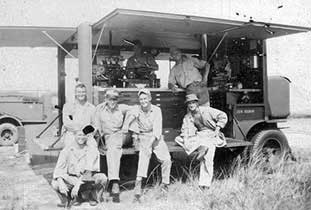 |
|
|
|
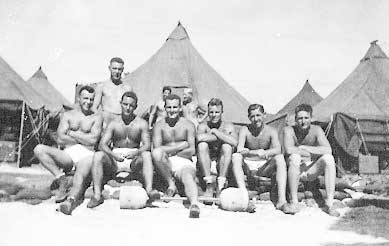 |
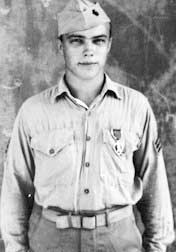 |
|
Men of headquarters squadron, MAG 31 |
Herbert H. Hice,
MAG 31 Motor Transport, Roi-Namur |
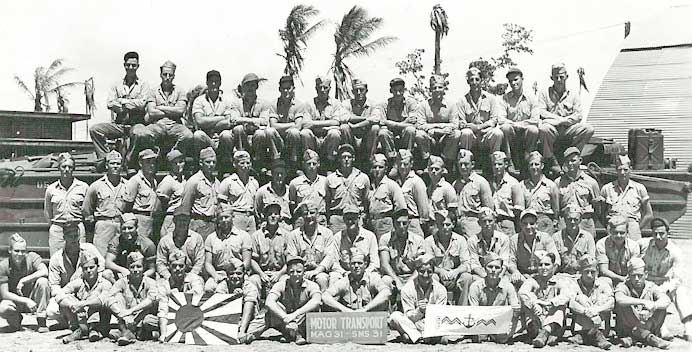
Roi-Namur 1944, MAG-31, Motor Transport
MAG-31 arrived at Roi February 7,
1942, five days after the 4th Marine Division captured the twin islands of Roi-Namur,
and
only two days after the last Japanese were killed by the 7th Infantry Division on Kwajalein Island, 50 miles to the south.

Roi-Namur, MAG-31, Motor Transport, SMS31
Picture provided by Herbert
H. Hice
A Walk Down Memory
Lane
Remember Pearl Harbor
Herbert Hice
 |
My first car, 1938 Ford
I bought it in 1940. I was too young so my sister signed for it. |
We decided to go over the bridge to Jefferson Avenue to the white castle. At that time, the white castle was near the bridge. I was a BIG spender in those days so we each had TWO hamburgers at 10 cents each and a coke at 5 cents each. We did not feel like going home yet so I drove back to Belle Isle. Gas was only 10 cents a gallon, so what the heck. I always had my radio turned on and as we parked to watch some of the big boats on the Canadian side of the island. The radio announcer told us that the Japanese attack on Pearl Harbor somewhere in Hawaii. He sounded excited. After my blonde showed me some more interesting things, I think I was more excited than he was. We stayed on the island for a few more hours and as I drove Betty home, we both started to grasp how serious the news was. We had no TV in those days so the first I saw how much damage the Jap bombers had done at Pearl Harbor was when I took Betty to the movies the next Saturday.
|
|
|
|
|

